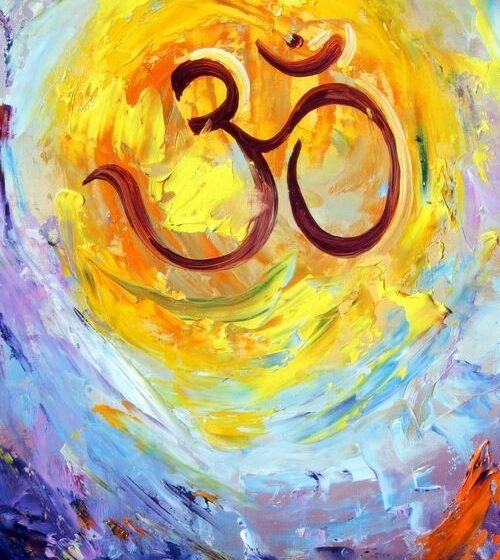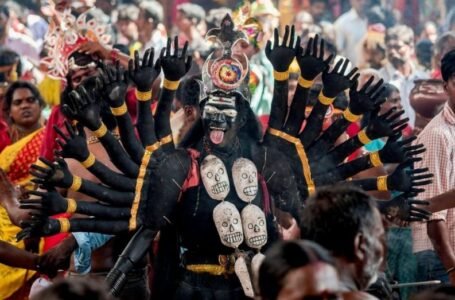Decoding Symbols of Hinduism: Om

Across India, the symbol of Om is widely used and seen. Painted above the doorframes of Hindu houses, behind the auto-rickshaws, outside the Hindu temples and shop fronts, the letter Om lingers in between the hustle-bustle of Indian cities and in the quiet of Indian villages. Chanted before and after the prayers, during the reading of the Holy Scriptures and during puja, and ceremonial rites of marriages, meditation and other spiritual activities, the symbol of Om found its emergence in the Vedas. The seemingly one word, consisting of three Sanskrit phonemes A, U, M, has been widely disputed in its meaning. From tracing its origin in the Upanishads—whose core value lies in discovering the relations between ritual, cosmic realities that is the ultimate truth, and the human body or person—translates one of the etymologies as ‘to attain.’ The letter Om and its written format in the ancient Indian Sanskrit language can be traced back to the 1500-2000 BC in the Vedas and other ancient Indian Sanskrit texts.

Om is a sound, a sound that represents and affirms the divine, delving into the spirituality that the Upanishads amount to, hence becoming the core symbol of spirituality in the Hindu religion. According to the Hindi Scriptures, and believed widely by its practitioners, the creation of the universe or the cosmos was caused by vibrations. The early stage of these vibrations is represented by the sound of Om. With this perspective the symbol also stands for the beginning, ongoing and the end of existence and all that exists.
According to Hindu Mythology, Om also symbolizes the Hindu Trinity consisting of the creator deities. This trinity of the Hindu Gods and their relation to the symbol of Om is found in the Puranas, a text that speaks of the legends and traditional lore of Hinduism, conceptualizing the syllable as the Trimurti. In Indian culture dealing with the Hindu belief system, the Trimurti represents the union of three Hindu Gods, namely Lord Brahma, Lord Vishnu and Lord Shiva. The phoneme A in the symbol stands for Lord Brahma the creator of the universe, U stands for Lord Vishnu the preserver of life or the universe and the phoneme M stands for Lord Shiva the destroyer of all the evil existing in the universe. Om also is believed to be a symbolic avatar of Lord Ganesha. The way the symbol is drawn is associated to be a loose form of the elephant God. The curve on the symbol’s left is viewed as the head and stomach, whereas the curve on the right is associated with the trunk. Hindus believe to worship Ganesha means to free ones path of the obstacles. This ideology is the basis of the symbol Om, as in order to connect spiritually one must overcome the worldly obstacles in order to reach the absolute truth and become one with the universe. Hence, the symbol is widely drawn in and around Hindu homes, workplaces, vehicles, or any new purchases or beginnings. In all its completeness the symbol Om represents spiritual attainment of mind, body and soul with that of the universe, meaning a profound connection between the creation and the creator.

In the Hindu practice of chanting of Om is limited to the count of 108. Mainly because once the three digit number is broken down and held on its own, it represents the bare truths of the universe and everything that exists in it. That is from nothing to everything. Number eight signifying infinity and the count of 108 as a whole, a reminder of reality of the universe. Since, the universe came into being from nothing to everything. Hindu devotees chant Om on a daily basis in order to achieve the wholeness of existence. Because of this connotation, the symbol of Om is also seen as a representation of the four stages of human consciousness. The A as the waking state as a symbol of the beginning, U as the dreaming state as a symbol of preservation and the bridge between the internal and external world, M as the deep sleep state or the unconscious mind as a symbol of destruction of the ego and the silent syllable as the state of Turiya, symbolizing the ultimate reality of existence. The Hindu Scriptures thus place a lot of emphasis on spirituality and a deep connection with the universe. Hence, the Om in the beginning of the Vedas encapsulates the entirety of the scriptures teaching.

Apart from Hinduism, Om also holds a paramount importance in other religions such as Buddhism, Jainism and Sikhism. Though Buddhism does not have the idea of a creator deity like Hinduism, the religious belief focuses on the sound of Om. Within Buddhist notions the sound of Om is said to resonate with the universal truth, and is inculcated during the practice of meditation and chanting, where the sound is used as a mantra to focus on the mind and cultivate mindfulness. Among the Tibetan Buddhist tradition, the chanting of Om pronounced as Aum, is associated with attaining enlightenment. While in Jainism, the chanting of the sound Om is a part of their prayers, meditation and spiritual contemplation. This is done in order to seek a connection with their inner selves and the universal consciousness. In Sikhism, Om is integrated with the oneness of God, as Sikhism which originated in the Punjab region of India is a monotheistic religion. The Sikh scripture uses the term ‘Ekh Onkar’ instead of Om, however the underlying concepts of cosmic unity and divine oneness is similar in the vibrations of its sound.

This teaching of the ancient Hindu Scriptures of attaining the unity of the body, mind and soul; connecting with the spiritual realms of one’s state of being, and finding the absolute truth by forging a sense of deep personal connection with the universe, has seeped past the soil of the Indian land where it first found its origin. In the modern world, with its fast paced life and little room to connect with the internal and external world, its inhabitants have turned to the teachings of the ancient. The symbol Om, because of this dire need to connect with oneself and the greater reality, holds profound significance beyond its traditional religious and spiritual texts and origins. The symbol now is a universal phenomenon, representing concepts of interconnectedness, harmony and balance. The symbol of Om apart from serving as a symbol of overcoming the obstacles and religious connotations, now also serves as a reminder of the importance of self-awareness, mindfulness of one’s surrounding and meditation in the midst of the hullabaloo of high-tech, fast paced, capitalist contemporary world. What once was a symbol finding its origin in the ancient Indian texts of Vedas, and Hinduism, Buddhism, Jainism, Sikhism and, what was once solely referred to its relation within Indian cultural context has broken all cultural and religious barriers by transcending beyond, by becoming a universal symbol accepted, acknowledged and embraced by people and cultures far different from the Indian rituals and cultural practices, who are in search for inner peace and spiritual fulfillment.

Om has become a household symbol with increasing popularity of yoga across the globe. During Yoga sessions, Om is chanted at the start of the class, signifying the beginning of forming a connection with the universe, and by ending the class with the same chant signifies the resuming of life and reality. In modern times, this widespread practice of yoga has allowed people to detach themselves from the ongoing, by connecting with the beginning and the end. With the help of meditation through yoga individuals are able to harmonize the beginning, ongoing and the end of the existence, simultaneously developing a sense of self-awareness within them. This individual practice gives the modern world a chance to connect with the external realities of the world, far away from the herd life. This search for individual spirituality has also caused a lot of westerners to make a pilgrimage to the Holy places, like the banks of Ganga river, the Kumb Mela, and Aashrams of various Gurus.

The symbolism of Om apart from traditional culture has also found itself to be a part of mainstream popular culture. Westerners as well as Indians, now carry the symbol in the form of tattoos, jewelry, clothing, serving as a reminder of a connection to something greater than oneself. This visual representation symbolizes the shared feelings of unity, inclusivity and shared humanity, and the interconnectedness of all beings.
On the other hand, in modern day India the symbol Om is thought to be as an equivalent of cultural identity. Om is seen globally, and recognized as a symbol of Indian spirituality, religious teachings and philosophy. Considered as one of the India’s most important symbol, it stands for India’s rich cultural and heritage identity. It reflects the country’s spiritual legacy, philosophical ideology, inspiring a way of life among Indians and now around the world.

Long back into the history of its origin in the ancient Indian Sanskrit texts of Vedas and the Upanishads, and its religious and spiritual philosophical practices of meeting with the unity of the mind, body and soul and the universe, to its modern methods of adoption and practices; the symbol Om remains to be a timeless light of spiritual wisdom, cultural richness and universal resonance. Holding the torch as the bearer of truth, and the universal innate desire of a human to form a deeper relationship, with the inner self, and the external world, the symbol Om continues to transcend the regional, religious and cultural boundaries.


